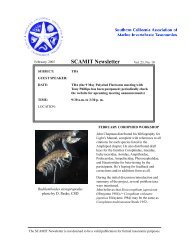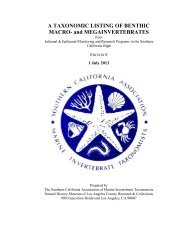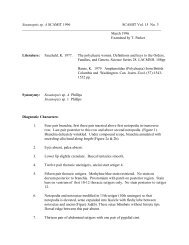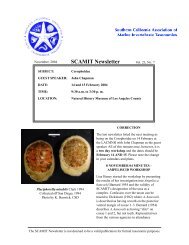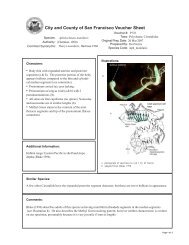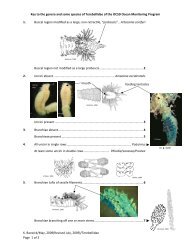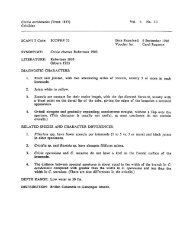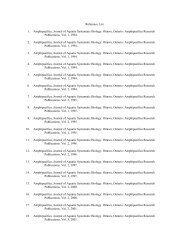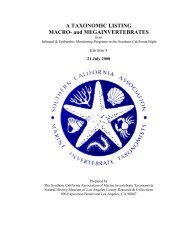SCAMIT Newsletter Vol. 4 No. 12 1986 March
SCAMIT Newsletter Vol. 4 No. 12 1986 March
SCAMIT Newsletter Vol. 4 No. 12 1986 March
You also want an ePaper? Increase the reach of your titles
YUMPU automatically turns print PDFs into web optimized ePapers that Google loves.
<strong>March</strong> <strong>1986</strong> <strong>Vol</strong>. 4, <strong>No</strong>. <strong>12</strong>Next Meeting: April 14, <strong>1986</strong>Guest Speakers:Cathy Crouch - Infauna of rocky intertidal surfgrasses fromsouthern California.Leslie Harris and John Dorsey - New syllidae (PolychaetousAnnelids) from southern California.Ann Martin - A new species of Lepidepecreum (Amphipoda:Lysianassidae) from southern California.Dave Montagne - New dorvilleid polychaetes from hydrogen sulfiderich benthic environments.Tony Phillips and Carol Paquette - The status of Leptognathia(Tanaidacea:Leptognathidae) from southern CA.Specimen Exchange Group:Topic Taxonomic Group:Serpulidae and SpirorbidaeSabellidaeMINUTES FROM: <strong>March</strong> 10, <strong>1986</strong>Guest Speaker, Dr. Jack Anderson, Director of the SouthernCalifornia Coastal Water Research Project, described newprojects that SCCWRP presently is conducting or will bepursuing. The major emphasis will be in the following areas:- Aromatic hydrocarbons in effluents and sediments- Sediment and interstitial water effects studies- Development of criteria for safe levels in sediments- Development of meaningful monitoring approaches- Increased understanding of currents and sedimenttransport in the southern California Bight- Examination of the sea surface microlayer- Coring for comparisons to historical concentrations- Relationship between bioconcentration and effects- Geochemical studies of multiple marine inputsThe major focus of these topics is on the concentrations andforms of toxic compounds associated with sediments, andultimate affects on associated organisms. <strong>SCAMIT</strong>'s role isFunds for the publication provided in part by Chevron, U.S.A. Inc.,Arco Foundation and Texaco, Inc.
important by helping to identify macrofauna in many benthicenvironments being studied by SCCWRP.A Renewal of the Chevron grant has just been received by <strong>SCAMIT</strong>.A check for $2,500 was accompanied by the following letter:Dear <strong>SCAMIT</strong> Members:In recognition of Chevron USA Inc's past and presentsupport of the Southern California Association of MarineInvetebrate Taxonomists (<strong>SCAMIT</strong>), attached is a checkfor $2,500 representing Chevron's donation to <strong>SCAMIT</strong> for<strong>1986</strong>.With this donation, Chevron wishes to assist <strong>SCAMIT</strong> in itscontinued service to the marine biological scientificcommunity, private industry, and public agencies in SouthernCalifornia.<strong>SCAMIT</strong>'s special Amphipod workshop, with Dr. J. L. Barnard, isscheduled for April 21-23. Please start to formulate questionsand topics that you would like to see included in this productivethree day event. Last year's workshop was a great success,as Dr. Barnard's instructions were a great help to all whobrought specimens and/or questions. Plan to attend this yeartoo! As a special attraction, Dr. Barnard will lead anearly morning (around 0700 hours) bird watching walk in theback bay of Newport on April 21st. A map is enclosed inthis newsletter.The ballots for <strong>SCAMIT</strong> officers in <strong>1986</strong>-87 have been mailed out tomembers. Please vote and return your ballots as soon aspossible.An announcement for the production of an Isopod <strong>Newsletter</strong> appearedin the latest issue of the Journal of Crustacean Biology.This notice will be of interest to some <strong>SCAMIT</strong> members andreads as follows:It has been the feeling for sometime among several isopodworkers that an Isopod <strong>Newsletter</strong> is long overdue.Amphipod and tanaidacean colleagues already benefitfrom such informal newsletters. While isopod workersare a fairly small, but nevertheless select group,increased communication at the informal level canonly enhance our discipline. Newcomers to the fieldwould also benefit by having a source of informationon specialists in particular taxonomic groups orother subdisciplines.-2-
The first issue of the Isopod <strong>Newsletter</strong> includes thenames and addresses of some isopod workers, along witha brief description of their specialties, areas of interest,and current projects. Other contents for future newslettersto be issued two or three times a year might well includereviews of isopod-related books and monographs, appeals forinformation and material, and perhaps a column for isopodpapers that have recently appeared.This first newsletter will be distributed to persons on acurrent mailing list. Suggestions for other names for thelist, as well as on the format and contents of the newsletter,are welcome.Send comments and suggestions to:Dr. Brian KensleyNHB Stop 163Smithsonian InstitutionWashington, DC 20560The annual meeting of the Southern California Academy of Scienceswill be held at California State University, San Bernardinoon May 2-3, <strong>1986</strong>. A contributed papers session for marineinvertebrate taxonomy is being hosted by <strong>SCAMIT</strong>. <strong>SCAMIT</strong>members are encouraged to participate in this session.A change for the <strong>1986</strong> <strong>SCAMIT</strong> agenda: Please make the followingchanges to your <strong>1986</strong> <strong>SCAMIT</strong> agenda (<strong>Vol</strong>. 4, <strong>No</strong>. 10)AUG EXCHANGE/SEPT TOPICNOV EXCHANGE/DEC TOPICBryozoaAscidiaceaList of Specimens from <strong>March</strong> 10, <strong>1986</strong>HYP 55 Ampelisca agassizi (Judd, 1896)HYP 56 Ampelisca sp A <strong>SCAMIT</strong>, <strong>1986</strong>LACO 70 Ampelisca milleri Barnard, 1954LACO 71 Ampelisca sp. to be resolved at workshopLACO 72 Byblis veleronis Barnard, 1954MBC 43 Ampelisca lobata Holmes, 1908MBC 44 Ampelisca sp A <strong>SCAMIT</strong>, <strong>1986</strong>PL 66 Ampelisca agassizi (Judd, 1896)PL 67 Ampelisca cristata Holmes, 1908SCCWRP 67 Ampelisca cristata Holmes, 1908
TRAVELS WITH OLGAGustafsson's PensionatSveavagen 108, 4reStockholm, 21 Sept. '39Dear Folks: I have been "mycket latt" (very lazy) regardingcorrespondence, but not because there has been nothing to writeabout. If writing came as easily as talking about something, youwould have heard a great deal, because there has been so muchto see and learn here.Every morning (except Sunday) I take the bus to the Riksmuseumin the country and return in the evening between 5 and 6.(I should have said 17 and 18, for we go almost entirely by the24 hour clock). Usually in the evening, there is the Swedishpaper (Tidningen) which takes me a long time to read. Englishpapers are not at all obtainable now, since all air-service hasbeen indefinitely discontinued. When it was still obtainable,I got the London Times, cost 55 ore (that is about 14 cents, hencequite expensive). In London it is two pennies (4 cents). Londonissues many penny papers, however (that is 2 cents).Stockholm is now in the midst of "brytt-sommer" (that meansthe breaking summer). It corresponds to an American Indian summerand is very beautiful. Frost may not be far off, but snows areusually not expected before about <strong>No</strong>vember. It does seem chilly,however.Seemingly a considerable number of Americans remain inStockholm. They label themselves usually when they begin to speak.An American can never be confused with an Englishman by virtue ofhis speech. One can always be sure of coming across Americansby loitering along Strandvagen, or in the vicinity of the Americancatering hotels. I suppose most people like to maintain theirliving habits, no matter where they are; - and that is possiblein most large cities of the world.Stockholm is of such size that one can comprehend it easilyenough in a few weeks (the same can certainly not be said of London).It is located, however, on many islands (13, by the way), soramnified by water ways that one needs to consult charts to keepone's bearings. By far, the most interesting part of the city isthe oldest part, the City between the Bridges or, as called inSwedish, "Staden mellan Broarna". It is a very small islandconnected to the "<strong>No</strong>rth City", and the "South City" by bridges,also to "Knight's Island (or Riddarholmen" on the west. On itlies the palace (Kungslslottet), the oldest church (Storkyrkan,sometimes called St. Nikolas) and many, very old buildings, somedating from the time of Birger Jarl, who founded Stockholm. Herethe streets are in some instances too narrow for any but cartvehicles, and then even lack sidewalks. Or sidewalks may be onlywide enough to walk single-file. Cobble stones are, of course,the surface. It is commonly said that the streets of European-4-
cities are paved with cobbles, and the same applies to many ofthe sidewalks.Most of the streets have names that sound strange to foreignears. Where I live it is the corner of Sveavagen and Odengatan.There are others, such as Birger Jarl Gatan, Drottningatan (theQueen's Way). Skeppsbron (the ship's bridge), Wahallagatan,Stureplan, etc., etc. Most of which have special significance.Words still confuse me. Thus, a key is a nyckel, anelevator a Hiss (when you press the button it says "hit"). Astreetcar is a sparvagen. A child is a barn and women are kvinnor,but a married woman is a fru. An ar is a year, but ar is a formof to be. When I go to the post office for 20 ore stamps (finmarken)I usually get 10 ore because although I know the differencebetween tjugu (20) and tio (10) , I am unable to pronounce themproperly.Matsedel (menus) still confound but interest me. Thus, tonightfor dinner I had the following (though not at all unusual here)smor och brod (butter and breads), koktlamm med dillsas (lambwith dill sauce) and for dessert (efferratt), there was rabarberkompottet med gradde (rhubarb with milk), and coffee. More populardesserts are "appelsoppe", or "filmjolk". There is always considerablevariety.A few days ago I received a trans-Atlantic air letter fromCalifornia that was 2 2 days enroute (hence longer than ordinarymail requires It must have lain over in England, perhaps in acensorship office. Today I received a letter from London which was8 days old. Service is obviously much crippled. <strong>No</strong> informationis given out regarding time or route of sailing of various boats.Work is progressing very profitably, and working conditionsare extremely ideal. Professor Bock is very helpful and a greatinspiration. He speaks English very fluently.Please have no concern over my welfare, for I can assure youthat Sweden is a very beautiful place (though it may be gettingcold). And adjustments are easily made.Enclosed a clipping that came to me from Los Angeles a fewdays ago, taken from the Los Angeles Times.I expect to be here at least through October (if not later)unless unexpected events decree otherwise.Greetings and best wishes.Post Scriptum: The stamps are 10 ore denomination. There are100 ore in a kronor. A kronor is about a quarter.
Anchicolurus occidentalis (Caiman 19<strong>12</strong>)Diastylidae <strong>SCAMIT</strong> <strong>Vol</strong>. 4, <strong>No</strong>. <strong>12</strong><strong>SCAMIT</strong> Code: PL 64 Date Examined: Feb. 10, <strong>1986</strong>Voucher by:Douglas DienerSynonymy: Colurostylis occidentalis Caiman 19<strong>12</strong>Literature: Caiman, W. T. 19<strong>12</strong>Diagnostic Characters:1. Telson short, sometimes difficult to see.2. Carapace with 3 parallel oblique ridges.3. Male with 2 small, ventrally projected, telsonic spines.Related Species:<strong>No</strong> other cumacean has telson and carapace characteristicsin this configuration.Distribution:Oregon to San Diego; 5-65 m F ; sand, silt bottoms,and within kelp beds.Figure 1. Female, lateral view (from Caiman, 19<strong>12</strong>)Figure 2. Female carapace, dorsal view (from Caiman, 19<strong>12</strong>)Figure 3. Male, lateral view (from MBC, unpublished)Figure 4. Male, telson (from MBC, unpublished)
Campylaspis nr. crispa <strong>SCAMIT</strong> <strong>1986</strong>Nannastacidae <strong>SCAMIT</strong> <strong>Vol</strong>. 4, <strong>No</strong>. <strong>12</strong><strong>SCAMIT</strong> CODE: LACO 68 (in part) Date Examined: Feb. 10, <strong>1986</strong>Voucher by:Douglas DienerLiterature: Lomakina, N.B. 1958.Diagnostic Characters:1. Carapace with a single shallow lateral sulcus(check carapace sculpturing carefully with figure).2. Pigment lines around sulcus are raised ridges.3. Inner margin uropodal peduncle lacks spines buthas short setae.Related Species and Character Differences:Campylaspis sp. B - anteriodorsal surface of carapacesmooth, with shallow pits, unlikeCampylaspis nr. crispa which has smallpustules (e.g. like C. rubromaculata);raised ridges around lateral sulcus areabsent in Campylaspis sp. B.Comments:C. nr. crispa differs from C. crispa Lomakina 1955 byhaving an antennal notch and pseudorostrum; uropodsare more slender with rami approximately 2/3 the lengthof the peduncle; rostral notch shallow and definedat ventral edge by small spine; inner margin of uropodinner ramus with four long spines (communicated byDon Cadien, MBC).Distribution: Pt. Estero to Coronado Canyon; 118-610 m.
Campylaspis nr. crispa <strong>SCAMIT</strong> <strong>1986</strong>Nannastacidae <strong>SCAMIT</strong> <strong>Vol</strong>. 4, <strong>No</strong>. <strong>12</strong>Figure 1.Male carapace (from Cadien, unpublished)Figure 2. Male telson (from Cadien, unpublished)Figure 3.Female telson; inner margin of uropod pedunclewith 8 spines, inner margin of endopodite with4 spines (from Phillips, unpublished).
Campylaspis hartae Lie 1969Nannastacidae <strong>SCAMIT</strong> <strong>Vol</strong>. 4, <strong>No</strong>. <strong>12</strong><strong>SCAMIT</strong> Code: HYP 52 Date Examined: Feb. 10, <strong>1986</strong>Voucher by:Douglas DienerSynonymy: Campylaspis sp. I Lie 1968Literature: Lie, U. 1969Diagnostic Characters:1. Carapace with unique sculpturing ridges show varyingdegree of development, but consistent with originaldescription.2. Some orange to red spotting along ridges, not to beconfused with pigment pattern of C. rubromaculata.Related Species and Character Differences:The male of C. hartae needs to be illustrated, someconfusion with C. rubromaculata is possible; compareridge patterns on carapace carefully. Both male andfemale of C. hartae the same pattern of anastomosingflat ridges elevated above general level of carapace.Distribution: Puget Sound to Point Loma; 9-300 m.
Campylaspis hartae Lie 1969Nannastacidae <strong>SCAMIT</strong> <strong>Vol</strong>. 4, <strong>No</strong>. <strong>12</strong>Figure 1. Carapace (from Lie, 1969)Figure 2. Telson (from Lie, 1969)Figure 3.Carapace (from MBG, unpublished)
Campylaspis rubromaculata Lie 1969Nannastacidae <strong>SCAMIT</strong> <strong>Vol</strong>. 4, <strong>No</strong>. <strong>12</strong><strong>SCAMIT</strong> Code: LACO 67 Date Examined: Feb. 10, <strong>1986</strong>Voucher by: Douglas DienerSynonymy: Campylaspis (papillata) lomikina in Lie 1968Campylaspis nodulosa Lie, 1969Campylaspis rubromaculata Lie, 1971Literature: Lie, U. 1968, 1969, 1971Diagnostic Characters1. Generally heavily pigmented (orange to red).2. Carapace with two complete and one partial lateralridge (see figure).3. Inner margin of uropodial peduncle with 4 to 6 smallspines.Related Species and Character Differences:Campylaspis rubromaculata can be confused with C^ hartae;compare the carapace sculpturing pattern carefully.Distribution: Puget Sound to San Diego; sand, silt bottoms,kelp hold fast; 6-640 m.
Campylaspis rubromaculata Lie 1969Nannastacidae <strong>SCAMIT</strong> <strong>Vol</strong>. 4, <strong>No</strong>. <strong>12</strong>Figure 1. Carapace (from Lie, 1969)Figure 2. Telson (from Lie, 1969)Figure 3.Carapace (from MBC, unpublished)
Campylaspis sp. B <strong>SCAMIT</strong> <strong>1986</strong>Nannastacidae <strong>SCAMIT</strong> <strong>Vol</strong>. 4, <strong>No</strong>. <strong>12</strong><strong>SCAMIT</strong> Code: Hyp 53, LACO 68 Date Examined: Feb. 10, <strong>1986</strong>Voucher by:Douglas DienerSynonymy: Campylaspis sp. B Myers & Benedict, unpublishedDiagnostic Characters:1. Carapace with single lateral sulcus.2. Top of carapace relatively flat, anterior with "S"shaped profile in female.3. Carapace relatively smooth, some pitting along mediancenter.Related Species and Character Differences:1. Other species with a single lateral sulcus include:a. Campylaspis canaliculata - with inflated andsmooth carapace.b. Campylaspis sp. E - with paired knobs (projections)on posteriodorsal surface of carapace, thoracicsegments 4/5, and on abdominal segments 1-4.c. Campylaspis sp. H - unknown, specimen lost.d. Procampylaspis sp. A - small tubercules surroundingsulcus, body surface with clinging detritus.Distribution: Pismo Beach to Point Loma; 22-440 m.
Campylaspis sp. B <strong>SCAMIT</strong> <strong>1986</strong>Nannastacidae <strong>SCAMIT</strong> <strong>Vol</strong>. 4, <strong>No</strong>. <strong>12</strong>1.0 mm1. Female (from T. Phillips, unpublished)2. Female telson (from T. Phillips, unpublished)3. Male telson (from T. Phillips, unpublished)4. Female (from B. Benedict, unpublished)5. Female carapace-dorsal view (from B. Benedict, unpublished).
Cyclaspis nubila Zimmer 1936Bodotriidae <strong>SCAMIT</strong> <strong>Vol</strong>. 4, <strong>No</strong>. <strong>12</strong><strong>SCAMIT</strong> Code: MBC 42 Date Examined: Feb. 10, <strong>1986</strong>Voucher by: Douglas DienerLiterature: Zimmer/ C. 1936Diagnostic Characters:1. Carapace with fine sculpturing, lacking teeth onanterodorsal portion.2. Carapace profile distinct (see figure).3. Usually with distinct pigment pattern particularly oncarapace, brownish spots at subrostral angle andposterior mid-dorsum of carapace.Related Species and Character Differences:This species could be confused with males of Cyclaspissp. C <strong>SCAMIT</strong> <strong>1986</strong> (see voucher for Cyclaspis sp. C, thisnewsletter, to compare carapace profiles).Distribution: Point Conception to San Diego; intertidal - 80 m. ;generally less than 20 m. within kelp beds andsand, silt bottoms.
Cyclaspis nubila Zimmer 1936Bodotriidae <strong>SCAMIT</strong> <strong>Vol</strong>. 4, <strong>No</strong>. <strong>12</strong>Figure 1. Adult female, x 15 (from Zimmer, 1936)Figure 2. Telson area, adult female, x 34 (from Zimmer, 1936)Figure 3.Adult female (from MBC, unpublished)
Cyclaspis sp.BodotriidaeA <strong>SCAMIT</strong> <strong>1986</strong><strong>SCAMIT</strong> <strong>Vol</strong>. 4, <strong>No</strong>. <strong>12</strong><strong>SCAMIT</strong> Code: MBC 41 Date Examined: Feb. 10, <strong>1986</strong>Voucher by: Douglas DienerSynonymy: Cyclaspis a sp. n Given 1970Cyclaspis sp. AMyers & Benedict, unpublishedLiterature: Given, R. 1970Diagnostic Characters:1. Anterodorsal carapace with one to several teeth alongthe median carina, tooth development more pronouncedin larger specimens.2. Carapace heavily calcified, often with a granularand pitted appearance.Related Species and Character Differences:This species resembles Cyclaspis nubila which lacks teethon the anterodorsal carapace.Comments:Cyclaspis sp. A and species of the genus Leucon can beconfused because the dorsal crests of both have one ormore teeth. These taxa can be distinguished by examiningthe number of exopodites present on the pereopods. Cyclaspishas only 1 pair of exopodites on both the male and female,whereas Leucon has 4 pairs of exopodites on the male and3 pairs on the female. Further, males of Leucon have 2pleopods while male Cyclaspis have 5.Distribution: Point Conception and Santa Cruz Island to SanDiego County; intertidal - 48 m; mainly found insand, silt bottoms, also within sediments ofkelp beds.
Cyclaspis sp. A <strong>SCAMIT</strong> <strong>1986</strong>Bodotriidae <strong>SCAMIT</strong> <strong>Vol</strong>. 4, <strong>No</strong>. <strong>12</strong>Figure 1.Figure 2.Figure 3.Adult maleAdult femaleOutline of carapace of miniature individual withonly a single spine.(All figures from Given, 1970).
Cyclaspis sp. C <strong>SCAMIT</strong> <strong>1986</strong>Bodotriidae <strong>SCAMIT</strong> <strong>Vol</strong>. 4, <strong>No</strong>. <strong>12</strong><strong>SCAMIT</strong> Code: HYP 54 Date Examined: Feb. 10, <strong>1986</strong>Voucher by: Douglas DienerSynonymy: Cyclaspis C sp. N. Given, 1970Cyclaspis sp. C.Myers and Benedict/ unpublishedLiterature: Given, R. 1970.Diagnostic Characters:1. Carapace of female with produced median carina, lessproduced in males; carina without teeth.2. Carapace heavily calcified, with sculpturing andsmall, shallow, irregular pits, unpatterned depressedarea on anterodorsum of carapace.3. Second somite of female usually dorsally produced,with sculptured patterning.Related Species and Character Differences:A female Cyclaspis sp. C superficially resembles Campylaspis,but its carapace lacks a dorsal median carina. MaleCyclaspis sp. C can easily be confused with male Cyclaspisnubila, Zimmer 1936; refer to the voucher for that species(this newsletter) and note differences in carapace profileand depressed areas.Distribution:Point Arguello and Santa Cr-uz Island to—San Diego-,intertidal - 30 m; mostly sand and sand-silthabitats, sediments within kelp beds.
Cyclaspis sp. C <strong>SCAMIT</strong> <strong>1986</strong>Bodotriidae <strong>SCAMIT</strong> <strong>Vol</strong>. 4, <strong>No</strong>. <strong>12</strong>1 mm(All figures from Given, 1970)Figure 1. Adult maleFigure 2. Ovigerous femaleFigure 3. Male uropods, x 100Figure 4. Right uropod, female, x 100Figure 5. Terminus of female uropodal endopod, enlargedto show terminal spine x 250
Diastylis sp. A <strong>SCAMIT</strong> <strong>1986</strong>Diastylidae <strong>SCAMIT</strong> <strong>Vol</strong>. 4, <strong>No</strong>. <strong>12</strong><strong>SCAMIT</strong> Code: LACO 69 Date Examined: Feb. 10, <strong>1986</strong>Voucher by: Douglas DienerSynonymy: Diastylis a sp. n Given 1970Diastylis sp. AMyers & Benedict, unpublishedLiterature: Given, R. 1970Diagnostic Characters:1. Carapace spinose except for large depressed sculpturedareas around the eye lobe, at top of head, and behindsubrostral notch.2. Telson approximately 1/2 length of uropodal peduncle.3. Lateral spines of telson vary from 2-7 pairs.Distribution:Cape Mendocino to San Diego; 25-190 m.; sand,silt bottoms.
Diastylis sp. A <strong>SCAMIT</strong> <strong>1986</strong>Diastylidae <strong>SCAMIT</strong> <strong>Vol</strong>. 4, <strong>No</strong>. <strong>12</strong>Figure 1. Carapace, dorsal view (from MBC, unpublished)Figure 2. Carapace, lateral view (from MBC, unpublished)Figure 3. Carapace, lateral view (from Given, 1970).Figure 4. Telson, (from Given, 1970)Figure 5. Telson (from Given, 1970)
Diastylopsis tenuis Zimmer 1936Diastylidae <strong>SCAMIT</strong> <strong>Vol</strong>. 4, <strong>No</strong>. <strong>12</strong><strong>SCAMIT</strong> Code: PL 65 Date Examined: Feb. 10, <strong>1986</strong>Voucher by: Douglas DienerLiterature: Zimmer, C. 1936Barnard, J. L.Given, R. R. 1961Diagnostic Characters:1. Female with one sternal spine on ventrum of fifththoracic somite, none on first pleonal somite.2. Carapace elongate and slender.3. Lateral telsonic spines variable in number, usually2-3 pairs.Related Species and Character Differences:Diastylopsis dawsoni: female has 2 sternal spines onfifth thoracic segment and 1 ventral spine on firstpleonal segment. Lateral telsonic spines 2-8 pairs(not a reliable character).Distribution:Central California (2 records), San FranciscoBay (1 record), Monterey Bay, but generally PointConception to Baja California; intertidal-30 m.but usually less than 18 m. on sand bottoms.
Diastylopsis tenuis Zimmer 1936Diastylidae <strong>SCAMIT</strong> <strong>Vol</strong>. 4, <strong>No</strong>. <strong>12</strong>Fig. 1. Diastylopsis tenuis Zimmer. A, male, 6 mm, sta. 4870, lateral view of animal; C, lower armature of male thoracicsegments 2-5 and abdominal segments 1-3; B, female, 8.5 mm, sta. 5043, lateral view of animal, with offset of developingbrood plates below and the ventral spine of thoracic segment 5.(Figure from Barnard and Given, 1961)
CUMACEAN LITERATUREBarnard, J.L. and R.R. Given. 1961. Morphology and ecology ofsome sublittoral cumacean Crustacea of Southern CaliforniaPac. Nat., 2(3): 153-165.Caiman, W.T. 19<strong>12</strong>. The Crustacea of the order Cumacea in thecollection of the U.S. National Museum. Proc. U.S. Nat. Mus.,41 (1876): 603-676.Given, R.R. 1970. Cumacea (Crustacea Peracarida) of California:Systematics, ecology, and distribution. Ph.D. dissertation,U.S.C.Lie, U. 1968. A quantitative study of benthic infauna in PugetSound. FISKERIDIREKTORATES. SKRIFTER, SERIE. HAVUNDERSOKELSER,14(5): 229-556.Lie, U. 1969. Cumacea from Puget Sound and off the northwesterncoast of Washington, with descriptions of two new species.Crustaceana, 17: 19-30.Lie, U. 1971. Additional Cumacea from Washington, U.S.A., withdescription of a new species. Crustaceana, 21(1): 33-36.Myers, B.L. and B.R. Benedict. 1973. Crustacea of the orderCumacea from the collection of Marine Biological Consultants,Inc. Unpublished.Zimmer, C. 1936. Calfiornia Crustacea of the order Cumacea.Proc. U.S. Nat. Mus., 83(2992): 423-439.




